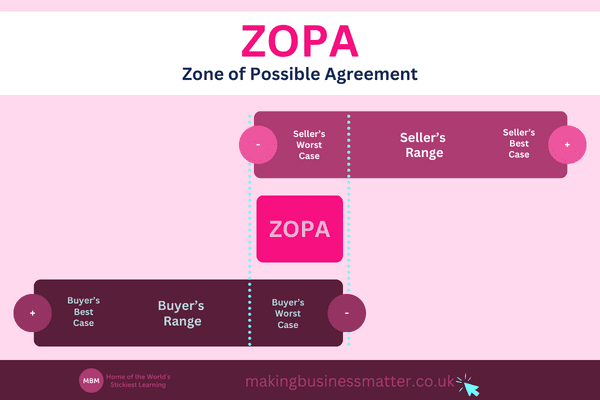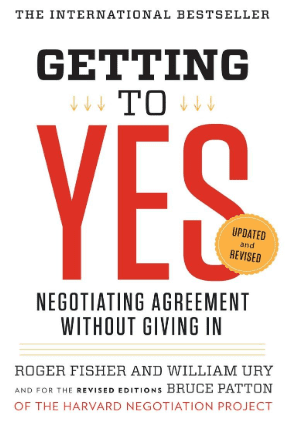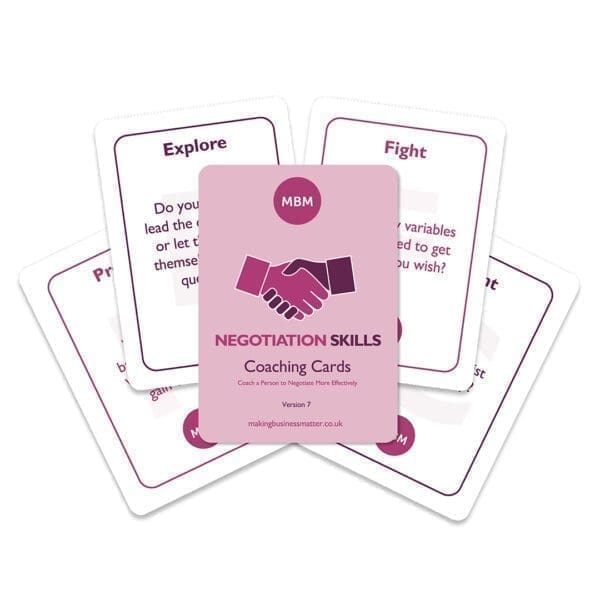Knowing Your ‘Zone of Possible Agreement’ Will Help You Find Common Ground in Negotiations – Even If You Can’t Agree Straight Away!
The Zone of Possible Agreement (ZOPA) in a negotiation is the ‘bargaining range’ between the ‘best’ offer one side is prepared to make, and the ‘worst’ offer the other side is willing to accept. These are their respective Best Alternatives to a Negotiated Agreement (BATNA.)
All in all, both sides need to be clear in their own minds about their BATNAs, before negotiations start. Furthermore, they need to be open about what these are. If their BATNAs overlap, there is a Zone of Possible Agreement. From there they can work to reach a common goal, a compromise that both sides find fair.
In a simple transaction like buying a used car from a private seller, the common goal is to agree on the price. Similar considerations apply in sales negotiations in business, for instance between a supplier and a big retailer. Here, finding the ‘ZOPA’ works the same way.
However, the supplier may be less inclined to reach an agreement if, for example, the customer makes demands in return for stocking the goods, which will incur costs. Here’s the thing. Establishing the Zone of Possible Agreement is also at the heart of the process in more complex negotiations involving many issues.
What You’ll Read Here

In this article we explore the Zone of Possible Agreement and Best Alternatives to a Negotiated Agreement. Points we cover, include:
- What is the Zone of Possible Agreement in a negotiation?
- What is the Best Alternative to a Negotiated Agreement?
- What is an example of a ZOPA and BATNA?
- How do you calculate a ZOPA?
- What is an example of a positive ZOPA?
- What are examples of ZOPA negotiations?
- 2 common mistakes people make about ZOPA
- What is BATNA negotiation?
- What are the benefits of ZOPA?
- What is the difference between BATNA and ZOPA in negotiations?
- What does ZOPA mean, beyond buying and selling and job interviews?
- Who came up with ZOPA?
- ZOPA negotiation PDFs and templates.
- How Making Business Matter can help boost your negotiations skills.
We’ll say more about our negotiation skills and other training at the end. But now, let’s look in more detail at ZOPA and BATNA.
What is the Zone of Possible Agreement in a Negotiation?
As we said at the start, the ZOPA is the bargaining range between the ‘best’ offer one side is prepared to make, and the ‘worst’ offer the other side is willing to accept.
What Is The Best Alternative to a Negotiated Agreement?
So, at its simplest, the Best Alternative to a Negotiated Agreement, or BATNA, is the lowest price you’re prepared to accept as the seller or the highest price you’re prepared to pay as the buyer. Or, if you’re negotiating about something else, it’s the best offer you can make, or the worst offer you’ll go with.
Hence, whether you’re buying a car or doing a business deal, you need to consider your respective BATNAs carefully before you go into the negotiation. Read our article on BATNA.
What is an Example of a ZOPA and a BATNA?
To take a simple example, say I’m looking to buy a car for between £2,500 and £3,500. You’re looking to sell me yours for somewhere between £3,000 and £4,000. As the buyer, the highest price I’m prepared to go with – my Best Alternative to a Negotiated Agreement (BATNA) is £3,500. As the seller, the lowest price you’ll consider – your BATNA -is £3,000. So, we have a ZOPA, or bargaining zone, between our respective BATNAs, of £3,000 to £3,500.
What is a Positive ZOPA?
There is a positive ZOPA in this instance because the seller’s lowest possible sale price is below the buyer’s highest possible buying price.
In the beginning, we also talked about another scenario. Here, a retailer agrees on a possible buying price with a supplier but also imposes charges for, say, their goods going through their internal logistics system. These extra costs could effectively add up to a ‘negative’ ZOPA as far as the supplier is concerned. So it wouldn’t be surprising if the supplier stepped away from the sale. But even in that case, all is not necessarily lost. They have made a connection, and both sides are interested in doing business – if they can agree on terms. We’ll come back to this.
What is a ZOPA Diagram?
You can express a ZOPA as a diagram:

What Are Other ZOPA Negotiation Examples?
Conversations about job offers are another important instance of ZOPA negotiations. Say you’re looking for a salary of £40,000-£50,000, and they’re offering you £35,000-£45,000. In this case, you have a ZOPA of £40,000-£45,000. In this ZOPA negotiation, you would also consider factors other than the salary, such as holiday time, and other benefits.
2 Common Mistakes People Make About ZOPA Negotiations
In real life, people often withdraw from negotiations because they can’t see a positive ZOPA, and come back later when there is a clear one. So, if the supplier we talked about just now does well and their brand grows, and they can operate comfortably at the scale the retailer needs, at that point there may be enough of a ZOPA to achieve a ‘win-win’ for everyone.
Actually, this bears out the insight that two common mistakes people make in negotiations are:
- Reaching an agreement when it wouldn’t be wise to do so because there isn’t a proper ZOPA:
- Walking away from a mutually beneficial outcome because you don’t think there’s a proper ZOPA, when in fact there is.
Business is about interacting with people, first and foremost. So if you have the connection and the common interest, make the most of it. But make sure the agreement works for both parties.
What is BATNA Negotiation?
This is a ‘catch-all’ term people use for this kind of negotiation, which simply means the same thing as a ZOPA negotiation. We’ve talked in depth about three examples:
- Selling cars to private buyers.
- Commercial suppliers and customers.
- The job offer process.
The ‘content’ of the negotiation is different in each of these examples, but the approach is the same, as it is in all such negotiations. The Corporate Finance Institute defines BATNA as ‘the most advantageous alternative a negotiating party can take if negotiations fail, and they can’t reach a better agreement.’ That’s the point.
So, know your BATNAs, and focus on finding the ZOPA in your negotiation. However, if the ZOPA’s there, but you don’t reach an agreement that day, keep the door open and come back another time.
What Are the Benefits of ZOPA?

In a bargaining negotiation, the buyer and seller debate the price or the nature of a transaction. Recognising the Zone of Possible Agreement enables them to:
- Stay friendly.
- Navigate the complexities of bargaining.
- Build on their shared interests.
- Work towards a mutually beneficial agreement.
All in all, grasping the dynamics of ‘ZOPA’ improves negotiators‘ ability to prepare for negotiations and adapt to situations as they change.
What is the Difference Between BATNA and ZOPA in Negotiations?
However well-intentioned the different parties might be, the process of negotiating a contract can be challenging at the best of times. The thing is, it’s worse if you don’t know your best alternative to a negotiated agreement (BATNA) and your zone of possible agreement (ZOPA.) Hopefully, as you read this, it’s all becoming clearer.
People talk about the “agreement trap,” the tendency to agree to a deal that isn’t as good as your BATNA. From salespeople to top executives, if we’re under pressure we can sometimes reach an agreement, even though there’s a significantly better deal available somewhere else. But it’s not a ‘good look,’ if you then have to back down because you’ve got back to the office and been told you can’t go ahead.
What Does Zopa Really Mean? Looking Beyond Buying and Selling, and Job Interviews
To repeat, a zone of possible agreement is a bargaining range in an area where two or more negotiating parties may find common ground. A ZOPA can only exist when there’s some overlap between each side’s expectations regarding an agreement. Hence, knowing your ZOPA/bargaining range is critical to the successful outcome of a negotiation.
ZOPA and BATNA in Negotiation
ZOPA and BATNA are useful in the context of selling used cars, manufacturers and customers, and job offers. Moreover, they are valuable tools in more complex negotiations, too.
In a scenario where there are many different issues needing to be addressed, it may take time to determine whether a Zone of Possible Agreement as such exists. In fact, the ZOPA may only become fully apparent after both sides explore their various interests and options. So, this is why it’s important to know your BATNA and your walk-away position and be open about it.
Who Came Up With ZOPA in the First Place?
Roger Fisher and William Fry made the phrase Zone of Possible Agreement famous, in their book Getting to Yes: Negotiating An Agreement Without Giving In.

Moreover, in it, they present some great tips to bear in mind in your negotiations:
4 Principles for Effective Negotiation:
- Separating ‘people’ from ‘the problem.’
- Focusing on ‘interests’ rather than ‘positions.’
- Generating a variety of options before settling on an agreement.
- Insisting that the agreement be based on objective criteria.
3 Kinds of ‘People’ Problems That May Arise:
- Different perceptions among the parties.
- Emotions such as fear and anger.
- Communication problems.
3 Criteria for Judging the Outcome of a Negotiation:
- If an agreement is possible, it should be a ‘wise’ agreement.
- It should be ‘efficient,’ meaning, it should work.
- The agreement should improve, or at least not damage the relationship between the parties.
ZOPA Negotiation PDFs And ZOPA Negotiation Templates
If you’d like to know more about ZOPA negotiation, check out Roger Fisher and William Fry’s book ‘Getting to Yes: Negotiating An Agreement Without Giving In.’ See the link above.
There are also various PDFs available online, with plenty of information about ZOPA negotiation scenarios to use in staff training and coaching. And speaking of training and coaching…
Play Your Cards Right, With Our Negotiation Skills Coaching Cards

>> Negotiation skills Coaching Cards <<
BATNA and the Bottom Line
Ultimately, BATNA analysis helps you determine each side’s reservation point or walk-away point in the negotiation. Don’t give up! If you’re able to come up with some agreed solutions that you would both prefer in place of a deadlock, then that means there is a Zone of Possible Agreement, and the best thing is for you to reach a settlement.
Make Your Negotiations Better – Talk to Us at Making Business Matter
We hope you’ve found this article helpful. All in all, as well as knowing about The Zone of Possible Agreement (ZOPA) and the Best Alternatives to a Negotiated Agreement (BATNA), you need negotiation skills to see you through. This is a key area in soft skills where Making Business Matter can help.
What Are Negotiation Skills? Learn More Here
You can find out more about these important tools in our Ultimate Guide to Negotiation Skills. At Making Business Matter, we offer customised soft skills training for manufacturing and retail companies that can help you boost your negotiation skills, creating win-win outcomes and building lasting, beneficial relationships. Our negotiation skills training course is one of our most popular programmes. We can come to you, or you can come to us. MBM’s training courses are also available for virtual delivery.

Here’s What You’ll Gain From Our Negotiation Skills Training
By the end of our Negotiation Skills training course, our learners will be able to:
- Understand their strengths and weaknesses, and how to reduce these weaknesses and improve their strengths.
- Recognise a good negotiation and a bad one, and be able to thoroughly explain why it was good or bad.
- Prepare for every negotiation using a structured approach.
- Identify which stage of the negotiation they are in, at any time during it.
- Use a variety of negotiation tools to reduce deadlock, solve problems, and get their points across more effectively.
- Have improved confidence when negotiating.
Look us up online, or call us for a chat. We can come to you, or you can come to us. Making Business Matter’s training courses are also available for virtual delivery. So, talk to us today!




